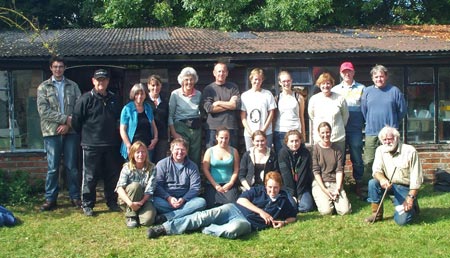The weather was against us again and the team arrived for work in steady rain which looked as if it had set in for the morning. Because of this we delayed the firing of the pots we made on Tuesday, due to take place this morning, and continued working on site. Despite the continuing rain and cold wind, the team progressed well with the excavation and recording of features, and even managed to stay cheerful - special mention must go to our motorcyclist, whose boots filled with water on the way to site… and yet still managed to put in a good morning’s work!
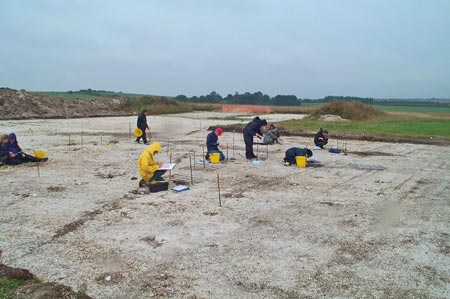
The weather lifted at around 11am and by noon John, our potter, was happy that firing could take place. We are pleased to report that this week’s pot firing was a complete success with 100% of our pots surviving the bonfire kilns. The team, under John’s supervision, built three kilns using smouldering coals and dry twigs, then waited for them to burn and fire the pots.
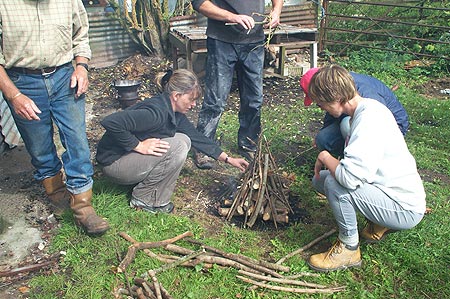
John kept a note of how long it took each kiln to reach different stages of the process (the results are shown below) and even though each kiln worked at a different rate, all produced successfully fired pottery.
|
Kiln one |
Kiln two |
Kiln three |
|
|
Fires laid at |
12.40 |
12.40 |
12.40 |
|
Flames appeared at |
12.53 |
12.57 |
1.03 |
|
Top of fuel burnt at |
1.00 |
1.07 |
1.20 |
|
All fuel burnt at |
1.16 |
1.23 |
1.26 |
|
Pots removed at |
1.45 |
1.45 |
1.45 |
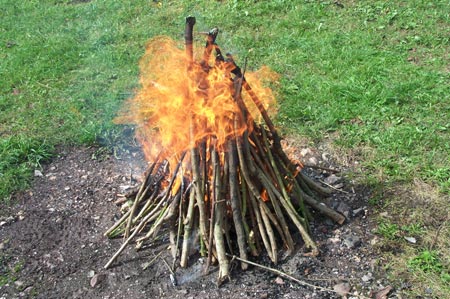
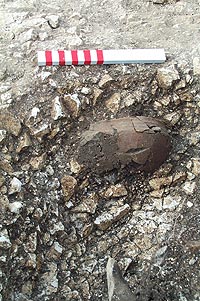 As the team left site for the last time we reflected on how much has been achieved over the past two weeks. Around eighty postholes have been cleaned and half of these have been dug. Work has started on two highly amorphous (‘blobby’!) features that we now believe to be quarry pits (current thinking, supported by Martin Green, is that the chalk was quarried and made into cob that was then daubed onto the walls of structures). Work was finished last week on what was probably a refuse pit, and work has started this week on two other similar features, one of which contains a collection of animal bone, burnt flint and pottery which may have been deliberately placed there. Good progress has also been made with a hearth pit that contained half of a bowl, broken in situ. The bowl has now been lifted and will be sent back to the Wessex Archaeology Finds Department for processing and analysis, while the material within it will be sent to our Environmental Department.
As the team left site for the last time we reflected on how much has been achieved over the past two weeks. Around eighty postholes have been cleaned and half of these have been dug. Work has started on two highly amorphous (‘blobby’!) features that we now believe to be quarry pits (current thinking, supported by Martin Green, is that the chalk was quarried and made into cob that was then daubed onto the walls of structures). Work was finished last week on what was probably a refuse pit, and work has started this week on two other similar features, one of which contains a collection of animal bone, burnt flint and pottery which may have been deliberately placed there. Good progress has also been made with a hearth pit that contained half of a bowl, broken in situ. The bowl has now been lifted and will be sent back to the Wessex Archaeology Finds Department for processing and analysis, while the material within it will be sent to our Environmental Department.
Most of the site has now been surveyed and we hope to be able to put a site map on-line soon (any suggestions as to how our postholes relate to one another or form structures will then be gratefully received!) The site has progressed brilliantly and our understanding of the earliest inhabitants of Down Farm is increasing.
The week ended with an extended tour of the farm, led by Martin, which helped our team to place the site they have worked on into its surrounding context. We would like to thank everyone who has worked on the site so far for their hard work and enthusiasm, they have all been a pleasure to work with, and we will continue to report on the progress of the site.
